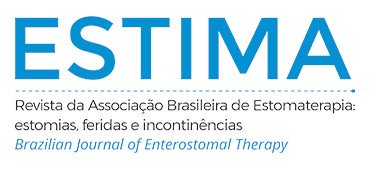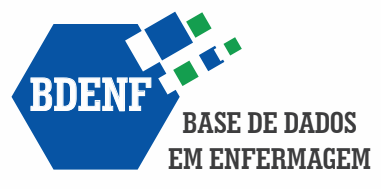IMPLEMENTED TECHNOLOGIES FOR PRESSURE INJURY PREVENTION IN THE HOSPITAL CONTEXT: INTEGRATIVE REVIEW
Abstract
The present study aimed to analyze in the literature the technologies implemented to prevent pressure injuries in the context of hospital care. This is an integrative literature review carried out from October to December 2021, in the databases: Virtual Health Library; MEDLINE via PubMed; Scopus; Web of Science; Embase and Cochrane Library, and 192 articles were included and 179 excluded. The final sample consisted of 13 articles, that met the eligibility criteria and answered the objective and research question. The main technologies used were air mattresses, permanent education mediated by e-learning, a computer system that facilitates the identification of risk factors, a light signal system for activating the team, a computer system for monitoring tissue pressure, a software for implementing computerized guidelines, an informative catalog, clinical guidelines, and a virtual learning environment. These technologies have shown positive results, however, as identified in the analysis, most studies deal with descriptive research designs with low inference power, which opens space for experimental research to prove the real benefits of technologies more accurately for pressure injury prevention.
Downloads
Metrics
References
National Pressure Ulcer Advisory Panel (NPUAP). Announces a change in terminology from pressure ulcer to pressure injury and updates the stages of pressure injury [Internet]. Westfor: NPUAP, 2016 [acessado em 20 abr.2022]. Disponível em: http:// www.npuap.org/national-pressure-ulcer-advisory-panel-npuap-announces-a-change-in-terminology-from-pressure-ulcer-topressure-injury-and-updates-the-stages-of-pressure-injury/.
Vasconcelos JDMB, Caliri MHL Nursing actions before and after a protocol for preventing pressure injury in intensive care. Esc Anna Nery 2017;21(1):e20170001. https://doi.org/10.5935/1414-8145.20170001
Fremmelevholm A, Soegaard K. Pressure ulcer prevention in hospitals: a successful nurse-led clinical quality improvement intervention. Br J Nurs 2019;28(6):6-11. https://doi.org/10.12968/bjon.2019.28.6.S6
Borghardt AT, Prado TND, Bicudo SDS, Castro DSD, Bringuente MEDO. Pressure ulcers in critically ill patients: incidence and associated factors. Rev Bras Enferm 2016;69(3):460-7. https://doi.org/10.1590/0034-7167.2016690307i
Sousa CR, Silva WF, Bezerra SMG, Silva BT, Damacena DEL, Silva JS. Avaliação da incidência e prevalência de lesão por pressão em um hospital de urgência. Uningá Rev J 2017;31(1):24-8.
Rabeh SAN, Palfreyman S, Souza CBL, Bernardes RM, Caliri MHL. Cultural adaptation of the Pieper-Zulkowski Pressure Ulcer Knowledge Test for use in Brazil. Rev Bras Enferm 2018;71(4):2092-100. https://doi.org/10.1590/0034-7167-2017-0029
Souza LEPF. Health, development and innovation: a contribution of the critical theory of technology to the discussion. Cad Saúde Pública 2016;32(Supl. 2):e00029615. https://doi.org/10.1590/0102-311X00029615
Costa IAP, Souza ML, Souza SCSM, Souza ACRH, Khanum S, Rangel RCT. Brazilian nursing technology production: an integrative review. J Nurs Care 2016;5(6):373. https://doi.org/10.4172/2167-1168.1000373
Soares CF, Heidemann ITSB. Health promotion and prevention of pressure injury: expectations of primary health care nurses Texto Contexto Enferm 2018;27(2):e1630016. https://doi.org/10.1590/0104-070720180001630016
Mendes KS, Silveira RCCC, Galvão CM. Integrative literature review: a research method to incorporate evidence in health care and nursing. Texto Contexto Enferm 2008;17(4):758-64. https://doi.org/10.1590/S0104-07072008000400018
Joana Briggs Institute. Critical Appraisal Tools [Internet]. Joana Briggs Institute; 2017 [acessado em 20 abr.2022 . Disponível em: http://joannabriggs.org/research/criticalappraisal-tools.html
Melny BM, Fineout-Overholt E. Evidence-based practice in nursing & healthcare: a guide to best practice. 4ª ed. Filadélfia: Wolters Kluwer Health; 2018.
Merhy EE. Em busca de ferramentas analisadoras das tecnologias em saúde: a informação e o dia a dia de um serviço, interrogando e gerindo trabalho em saúde. In: Merhy EE, Onoko R, editores. Agir em saúde: um desafio para o público. 2ª ed. São Paulo: Hucitec; 2002. p. 113-150.
Page MJ, McKenzie JE, Bossuyt PM, Boutron I, Hoffmann TC, Mulrow CD, Moher D. The PRISMA 2020 statement: an updated guideline for reporting systematic reviews. Int J Surgery 2021;88:105906. https://doi.org/10.1016/j.ijsu.2021.105906
Quaglini S, Grandi M, Baiardi P, Mazzoleni MC, Fassino C Franchi G, Melino S. A computerised guideline for pressure ulcer prevention. Int J Med Informatics 2000;58-59:207-17. https://doi.org/10.1016/s1386-5056(00)00088-5
Lyder CH, Preston J, Grady JN, Scinto J, Allman R, Bergstrom N, Rodeheaver G. Quality of care for hospitalized Medicare patients at risk for pressure ulcers. Arch Intern Med 2001;161(12):1549-54. https://doi.org/10.1001/archinte.161.12.1549
Finnegan MJ, Gazzerro L, Finnegan JO, Lo P. Comparing the effectiveness of a specialized alternating air pressure mattress replacement system and an air-fluidized integrated bed in the management of post-operative flap patients: a randomized controlled pilot study. J Tissue Viability 2008;17(1):2-9. https://doi.org/10.1016/j.jtv.2007.09.009
Jacobson TM, Tescher AN, Miers AG, Downer L. Improving practice: efforts to reduce occipital pressure ulcers. J Nurs Care Quality 2008;23(3):283-8. https://doi.org/10.1097/01.NCQ.0000324595.29956.90
Magnan MA, Maklebust J. Multisite Web-based training in using the Braden Scale to predict pressure sore risk. Adv Skin Wound Care 2008;21(3):124-33. https://doi.org/10.1097/01.ASW.0000305420.73597.d2
Tzeng HM, Grandy GA, Yin CY. Staff response time to call lights and unit-acquired pressure ulcer rates in adult in-patient acute care units. Contemp Nurse 2013;45(2):182-7. https://doi.org/10.5172/conu.2013.45.2.182
Padula WV, Mishra MK, Makic MBF, Valuck RJ. A framework of quality improvement interventions to implement evidencebased practices for pressure ulcer prevention. Adv Skin Wound Care 2014;27(6):280-4. https://doi.org/10.1097/01.ASW.0000450703.87099.5b
Padula WV, Gibbons RD, Valuck RJ, Makic MBF, Mishra, MK, Pronovost PJ, Meltzer DO. Are evidence-based practices associated with effective prevention of hospital-acquired pressure ulcers in US academic medical centers? Med Care 2016;54(5):512-8.https://doi.org/10.1097/MLR.0000000000000516
Smith SK, Ashby SE, Thomas L, Williams F. Evaluation of a multifactorial approach to reduce the prevalence of pressure injuries in regional Australian acute inpatient care settings. Int Wound J 2018;15(1):95-105. https://doi.org/10.1111/iwj.12840
Horup MB, Soegaard K, Kjolhede T, Fremmelevholm A Kidholm K. Static overlays for pressure ulcer prevention: a hospitalbased health technology assessment. Brit J Nurs 2020;29(12):24-8. https://doi.org/10.12968/bjon.2020.29.12.S24
Hudec R, Matúška S, Kamencay P, Benco M. A smart IoT system for detecting the position of a lying person using a novel textile pressure sensor. Sensors 2020;21(1):206. https://doi.org/10.3390/s21010206
Pott FS, Ribas JD, Silva OBM, Souza TS, Danski MTR, Meier MJ. Algoritmo de prevenção e tratamento de úlcera por pressão. Cogitare Enferm 2013;18(2):238-44. http://dx.doi.org/10.5380/ce.v18i2.26085
Araújo TMD, Araújo MFMD, Barros LM, Oliveira FJGD, Silva LAD, Caetano JA. Educational intervention to assess the knowledge of intensive care nurses about pressure injury. Rev Rene 2019;20:e41359. https://doi.org/10.15253/2175-6783.20192041359
Murray E. Bridging the theory-practice gap in pressure injury prevention for assistants in nursing: the impact of a formal education program at St Vincent’s Private Hospital. Wound Pract Res 2012;20(3):124-8.
Law J. Pressure ulcer prevention: education for nursing home staff. Brit J Nurs 2003;12(9):566-9. https://doi.org/10.12968/bjon.2003.12.9.566
Downloads
Published
How to Cite
Issue
Section
License
Copyright (c) 2022 Emily Batista Araújo, Sandra Marina Gonçalves Bezerra, Jéssica da Silva Machado , Indyara Maria Barros Silva, Luís Felipe Oliveira Ferreira, Jefferson Abraão Caetano Lira, Rosane Santana

This work is licensed under a Creative Commons Attribution 4.0 International License.

























